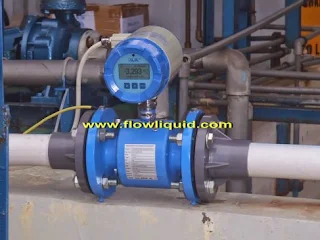Type and Model of Flow Meter
Measuring the flow of liquids is a critical need in many industrial plants. In some operations, the ability to conduct accurate flow measurements is so important that it can make the difference between making a profit or taking a loss. In other cases, inaccurate flow measurements or failure to take measurements can cause serious (or even disastrous) results.
With most liquid flow measurement instruments, the flow rate is determined inferentially by measuring the liquid's velocity or the change in kinetic energy.
Velocity depends on the pressure differential that is forcing the liquid through a pipe or conduit. Because the pipe's cross-sectional area is known and remains constant, the average velocity is an indication of the flow rate. The basic relationship for determining the liquid's flow rate in such cases is:
where
Q = liquid flow through the pipe
V = flow velocity
A = sectional area of the pipe
Flow Meter Comparison Table
| Type | Working Principle | Best For | Accuracy | Key Features |
|---|---|---|---|---|
| Turbine Flowmeter | Rotational blade movement | Clean liquids & gases | ±0.1% | High accuracy, single moving part |
| Electromagnetic | Faraday's law of induction | Conductive liquids | ±0.5% | No pressure drop, corrosion-resistant |
| Ultrasonic | Doppler effect/Time-of-flight | Liquids with particles (Doppler) Clean liquids (Transit-time) |
±1-2% | Non-invasive, bi-directional |
| Positive Displacement | Mechanical chambers | High-viscosity liquids | ±0.5% | Good for custody transfer, no power required |
| Thermal Mass | Heat transfer principle | Gas flow measurement | ±1% | Direct mass flow measurement |
| Coriolis Mass | Coriolis effect | Liquids, slurries, gases | ±0.1% | Measures mass directly, high accuracy |
Turbine Flowmeter

Turbine meters have found widespread use for accurate liquid and gas measurement applications. The unit consists of a multiple-bladed rotor mounted within a pipe, perpendicular to the liquid flow. The rotor spins as the liquid passes through the blades. The rotational speed is a direct function of the flow rate. Electrical pulses can be counted and totalized.
Features:
- Highly accurate and repeatable
- Excellent long-term reliability
- Installation flexibility
- Economical solution for high-accuracy applications
- Single moving part reduces maintenance
- Wide selection of materials and output options
The turndown ratios may exceed 100:1 when calibrated for specific fluids at constant conditions. Accuracy may reach ±0.1%.
Electromagnetic Flowmeter

Operates on Faraday's law of electromagnetic induction where voltage is induced when a conductor moves through a magnetic field. The liquid serves as the conductor, with magnetic fields created by energized coils outside the flow tube.
The voltage produced is proportional to flow rate. Electromagnetic flowmeters handle corrosive liquids and slurries, measuring flow in both directions with equal accuracy. Requires electrically conductive fluids and has relatively high power consumption.
Ultrasonic Flow Meter

Doppler meters measure frequency shifts caused by liquid flow using transducers mounted on the pipe. Require particles or bubbles for measurement, making them unsuitable for clean liquids.
Time-of-travel (Transit-Time) meters have transducers on each side of the pipe at 45° angles. Measure speed differential of signals traveling with/against flow. Require relatively particle-free liquids.
Ultrasonic meters offer non-invasive measurement with clamp-on models available. Doppler types are generally less accurate but more affordable than transit-time meters.
Positive-Displacement Flowmeters
PD meters mechanically trap fluid in compartments, counting the displacement cycles. Still widely used for custody transfer of oils despite competition from Coriolis meters.
Features:
- Excellent for high-viscosity liquids
- Simple mechanism with minimal wetted parts
- Gear system mounted externally for easy maintenance
- No power required for basic operation
Thermal Mass Flow Meter
Measures gas mass flow based on constant temperature differential technology. Determines flow by measuring heat dissipation without needing temperature/pressure compensation.
Features:
- Range: 0-160 NMPS
- Available in inline (1"-12") or insertion configurations
- Outputs: 4-20mA, pulse, RS-485, HART
- Reduces installation complexity
Coriolis Mass Flowmeter

Measures mass flow, density, and temperature using vibrating tubes. Coriolis forces created by fluid flow cause measurable tube distortion proportional to mass flow rate.
Features:
- Direct mass flow measurement
- Accuracy: ±0.1%
- Handles liquids, slurries, and gases
- No flow conditioning required
- Stainless steel wetted parts (SUS316L)
- Immune to viscosity/density changes

Komentar
Posting Komentar
Informasi Pilihan Identitas:
Google/Blogger : Khusus yang punya Account Blogger.
Lainnya : Jika tidak punya account blogger namun punya alamat Blog atau Website.
Anonim :